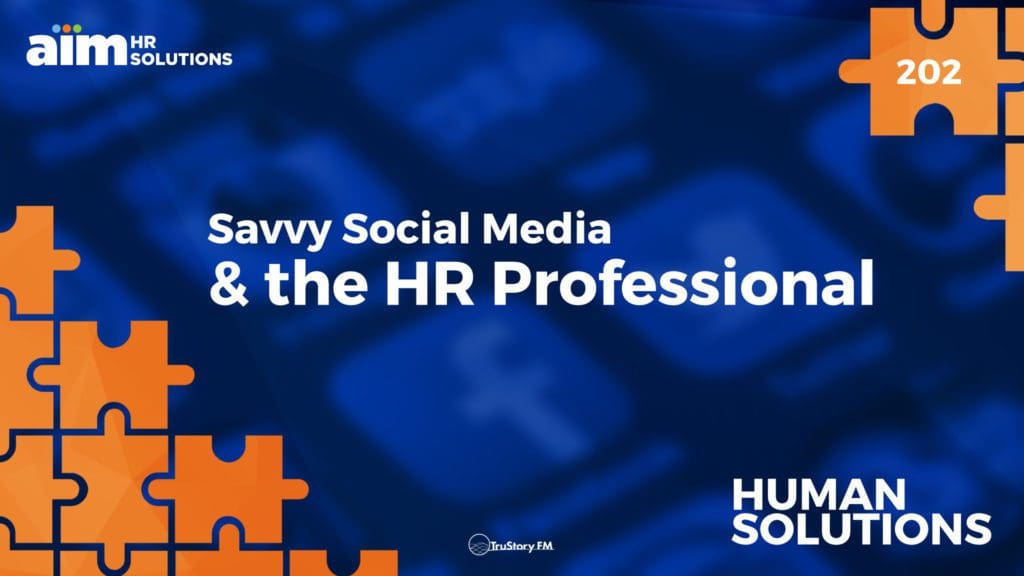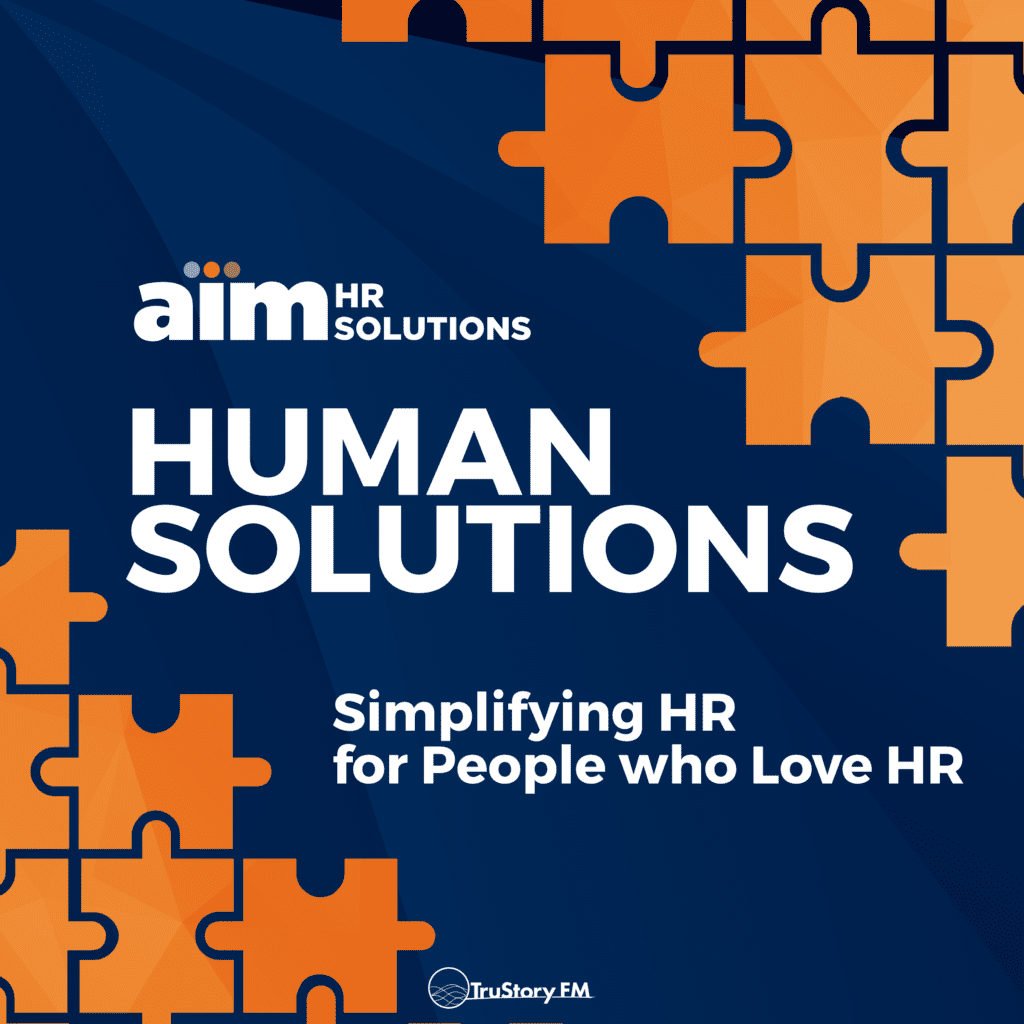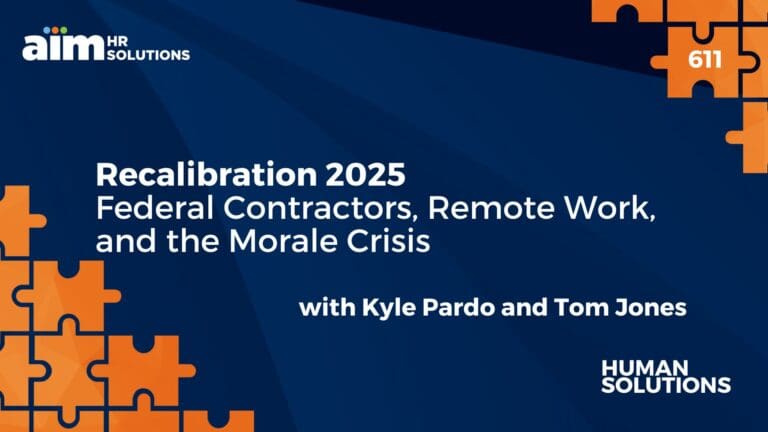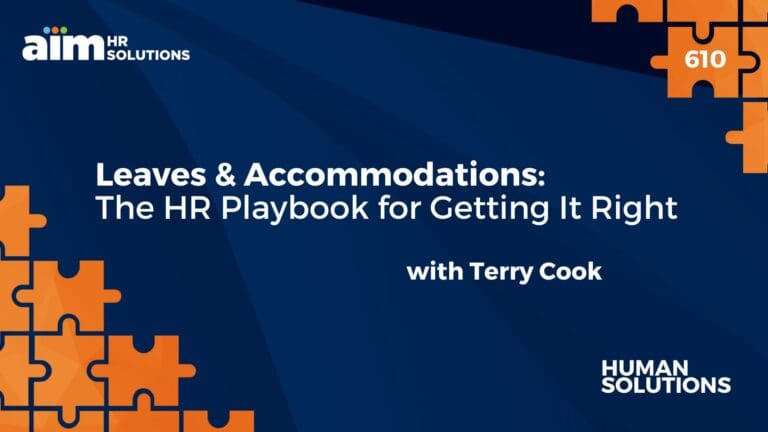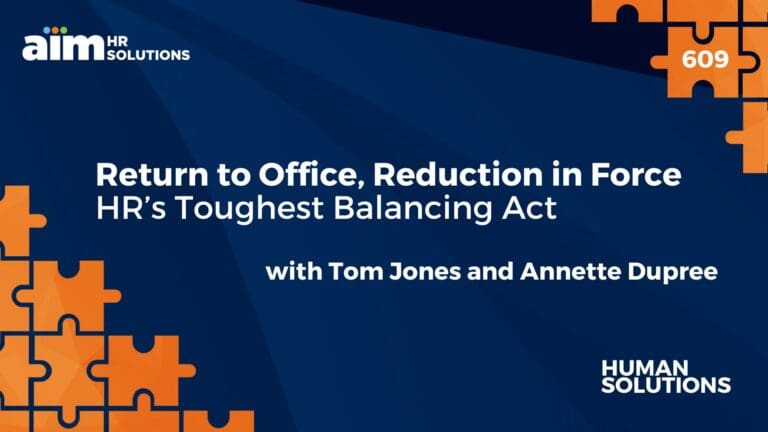Social Media. You might not personally be an Insta-influencer or TikTok star, but there’s an increasingly good chance that your employees are. How does their activity in their private lives impact what they do at work, and how does your organization’s social media policy guide your most public participants?
This week, Terry Cook, our Senior Vice President of Employer Services, and Tom Jones, our very own attorney specializing in labor and employment matters, join Pete Wright to share what you can do to support and guide your team’s best influencers.
Links & Notes
- “Apple is allegedly threatening to fire an employee over a viral TikTok video” — theverge.com
- “Ask HR: Can Employees Be Disciplined for Their Social Media Posts?” — SHRM.org
Episode Transcript
Pete Wright:
I’m Pete Wright, welcome to Human Solutions.
Social media, that you might not personally be an Insta influencer or a TikTok star, but there’s an increasingly good chance that your employees are. How does their activity and their private lives impact what they do at work, and how does your organization’s social media policy guide your most public participants?
This week, Terry Cook, our Senior Vice President of Employer Services, and Tom Jones, or TikTok Tom as we know him, our very own attorney specializing in labor and employment matters join me this week to share what you can do to support and guide your team’s best influencers.
Tom, Terry, welcome. Should we share your favorite profiles, how many followers, just to establish your credibility on the show before we start? Oh, we’ve got a goose egg from Tom. All right, I want to start, I think a lot of these conversations in and around HR start with the negative, right? Oh my gosh, how terrifying is it that our employees are out there using social media? They might actually mention our company name. Ah.
I feel like let’s start on the other side of that conversation. You’re in HR and legal employment matters, do you see any truly good things about having an engaged participating employee populace in social media? Terry, you start. I think Tom might be a curmudgeon on this, so I’m going to have you lead.
Terry Cook:
Well, I do see that, I mean, especially when it comes to recruiting. So many more applicants are going to the reviews for the company on Glassdoor or other social media platforms to see what employees are saying. So it’s nice to know that, although there are some people that will complain and they’ll be recognized in an interview, more often than not lately I’ve been hearing about people that are focusing on the good things that these people are saying about their company, their benefits, their coworkers.
A lot of reasons people want to come to work at a company now has to do with the culture of the company and the beliefs of the company, and they want to see how the employer is interacting with the employees. So, yes, there’s definitely positive notes on social media, on review sites, but especially on social media and LinkedIn, when they see somebody that’s saying look at the great things my company’s doing now, those things are being noticed. I think they’re not only noticed by applicants, but they’re being noticed by each other, by coworkers to say, “Geez, I didn’t know that about my company.” So, there are some positive pieces, Pete, you’re right.
Pete Wright:
Well, I appreciate that, because I had a conversation with a social media consultant not very long ago, and we were talking about getting ready for this show. She said to me that an employee base that is engaged becomes the public barometer for the cultural health of the institution. I think that’s a really interesting way to look at it, and I wonder if it is taking a little bit of time for managers to see it that way too. Tom, what do you think?
Tom Jones:
I definitely agree with that. I think it’s going to take a little more time. I mean, a lot of managers have been in their job for years and have been successful at their job for years with the status quo. They may have seen their kids introduce the world to social media, but they’ve seen it outside of work, the work setting.
I think to the extent it’s something that can’t be fully controlled in the workplace, it causes some anxiety and some concern with managers, that people might be saying something … you’re right. I mean, if you look at my lawyer’s hat, it’s going to say, well, if you link whatever’s being said on social media with that employee of the company, that raises a question about the company’s reputation, potential damage to the company, but it’s perhaps time to take a step back and look at it and take a breath and say, “Well, gee, is this going to hurt us?”
But then that probably raises a bigger question, which is that how should your social media policy handle issues like that? If Terry’s a manager, I’m a manager, you’re a manager, Jillian’s a manager, we all take different approaches, that’s not good for the company, because we want to have some consistency.
Pete Wright:
Right.
Tom Jones:
So, it would mean an organization sitting down and thinking, okay, how do we have a reaction to social media? Do we have one? Do we care about it? If we do care about it, what’s going to be the actual focus of our reaction?
Pete Wright:
Well, I’m glad you brought that up and you dropped social media policy just as I did in our little introduction here, and I did it almost as a joke, because I wanted to see who would respond. How many companies that you work with have a strong social media policy?
Tom Jones:
Well, I think a pretty good number.
Pete Wright:
Yeah?
Tom Jones:
Yeah, in their handbooks, a lot of the handbooks that Terry and I look at for companies have social media policy.
Pete Wright:
Okay.
Tom Jones:
About 10 years ago, the National Labor Relations Board came up with a model policy and the kind-
Pete Wright:
It makes it pretty easy to start to adopt-
Tom Jones:
Exactly.
Pete Wright:
Once you have the template, yeah.
Tom Jones:
Yeah, two key things.
Pete Wright:
Okay.
Tom Jones:
One was that what you can say about at work, what’s protected speech at work. So if I don’t like how my supervisor issues overtime assignments and I complain about it on social media, that’s protected speech, because I’m complaining about work. But if I just say I don’t like my supervisor, because she’s a nasty person or he’s a nasty person, that’s a whole different story, that’s not protected.
So, companies are kind of learning with this policy how far can we go and how far can we draw the boundaries for our employees to say, okay, that’s acceptable, that isn’t acceptable. Because a lot of supervisors have a visceral reaction. If they’re being attacked on social media, they’re going to say, “Well, wait a minute. You’re coming after me and I’m not going to like that.”
Pete Wright:
Yeah. Low and behold, they’re also human beings and-
Tom Jones:
Exactly.
Pete Wright:
Surprise, surprise. Terry, what is your position when you work with companies in the scope of your work with AIM around how social media is to be addressed, monitored, communicated internally?
Terry Cook:
Well, I think as Tom said, it’s really important to step back and think about your reaction before you immediately react. As you mentioned, everybody’s human, nobody wants to be attacked. Before if somebody said some horrible things to you, they may have said it to your face at work, but it wasn’t public for the whole world to see like it is now on social media, so your instinct might be to react in an incorrect way.
So what I usually will tell people is before you react, you can look at your policy, you certainly can look at what Tom said to see if it is protected activity, but even more importantly, just think about the right way to react. So as a human resources person, if somebody’s complaining, instead of coming right to a discipline or a harsh statement, why not sit down and have a conversation with them and say, “Geez, I heard from somebody that you may be upset about X, Y, and Z. Why not come in here and talk about it? Let’s talk about it together and see how we can make it better for you and make it better for the company, instead of just continuing to be upset and angry at everybody.”
So, it’s almost like stepping back and taking time to react and really just getting to the root of the problem versus just jumping to a president that doesn’t want somebody talking about somebody at the company and just immediately said, “I want to fire that person.” Finding out why, finding out what’s going on, determining your policy, determining what might be protected activity. As Tom said, with the National Labor Relations Act, they do have the template of a policy, but they’re also the ones that are there to defend people that are doing something that’s protected that they got terminated for.
So, if you’re just complaining overall about the way you’re treated at work and the way something’s happening at work, and you’re connected on social media with other people you work with, that’s considered protected activity, even if they’re not in a union company. It’s called concerted activity and you’re supposed to allow people to have open conversations. Of course, what that does is certainly encourages union activity if you’re in a non-union environment, because they’re going to say, “I could protect you. That’s something that you shouldn’t have had a problem with at work, because you were just communicating your concerns about workplace activities with your coworkers on social media.”
Pete Wright:
Tom, let’s start at the top and figure out what a … We have this fancy manufacturing organization that we created last season, and we’re very excited. It’s been growing and thriving and now it has a number of people and they’re fulfilling orders from clients across the country. How would you start by building this, not just a social media policy that is appropriate to we’ll say standards, but a culture around communicating social media across the organism that is the organization? Where do you start?
Tom Jones:
I mean, I’d echo a lot of what Terry said to begin with. You try and figure out what is going on, if anything. I mean, it raises a question for me, and I don’t know the answer to this how many companies are doing this, should you have somebody actively monitoring your social media presence?
Some companies do. Typically when they go into hiring phases or when they go into other phases, they’ll check the Glassdoors and the Indeeds to make sure that they’re not being trashed by different ex-employees, but are people doing it on a constant basis? Terry, I don’t know if that’s true. Are you seeing companies do it a lot?
Terry Cook:
I think people will do it more when somebody brings it to their attention. I don’t know that they have somebody to your point, Tom, that that’s part of their job to monitor it on a regular basis. I think their ears are open for other people, and a lot of employees do connect directly with their managers on social media. So they don’t even have to wait to hear it, they see it themselves.
Pete Wright:
I will say as point of background. I come from a public relations background at a very, very large organization, and I can tell you that in the communications department, we had constantly running filters for mentions of our organization, and we were able to filter down through the organization directly to managers when issues arose.
Now that was some years ago, and my hunch is that those filters are still running, but the scope and scale of what we’re having to track now is very, very large, and so you’re going to need some of those things to bubble up in order for the right people to see them. Correct me if I started lying there, Tom.
Tom Jones:
No, I think you’re right. I think it’s a huge production nowadays. You think about all the different platforms you can use sitting on your phone to communicate with people. I mean, companies will oftentimes try and focus on the sort of narrow things. For example, no cell phones in the workplace, because you could take pictures of what might be confidential or proprietary information. I take a picture of you, Pete, working. I work with you, but behind you are the plans for some key thing that the company makes, so they’ll focus on things like that, or they’ll focus on things that are tangible and come to their attention.
I think most beta manufacturing or a logistics company or other things like that are not going to have the team in place to do that social media monitoring, unless of course that’s the market they’re heading toward. If they’re in that business, that’s one thing, but for the average company, I think that’s probably going to be a big challenge to try and figure out how to do that, unless it actually occurs in a particular thing.
Pete Wright:
Sure, sure. Well, one of the examples that has kind of cropped up and, as we record this, this is just days old, and so it is an unresolved situation, but it does occur with a very large company in the technology space. In this case, it’s Apple. There is a social media influencer with about a half a million followers on TikTok who jumped in to a conversation where somebody was nervous about something happening with their phone, the security of their phone.
This influencer who also works at Apple is an engineer and happens to know specifically what happens when this case comes up. A phone is stolen, somebody is trying to get them to turn off the protection on their phone or else they’ll send all the pictures that are on the phone to the internet and expose them.
This engineer stepped in and said, “I can’t really tell you how I know, but I do happen to know that you should not turn off the security on your phone and it’s going to be fine, because your phone is secure. You should never turn off your security.” That was it. There was no mention that this person happened to work specifically for Apple. They did say in their TikTok video, “I happen to be a support engineer at a company that talks a lot about fruit.”
So, I think you could probably make the case that they inferred they work at Apple. But this employee had never mentioned that they actually work at Apple, and the news that broke was their manager said that they were going to be terminated for violating their social media policy. This has bubbled up, because it demonstrated very quickly the separation between individual manager’s awareness of what the policy was and that very human reaction to something happened we’re out of control over, and we don’t know how to handle it so we just need to make it go away. In some cases, making it go away is the employee needs to be removed.
I wonder, just hearing my very loose explanation of that story, does that sound like something that is a reasonable expectation or that would’ve happened? What would your guidance be to a manager in that position?
Tom Jones:
I mean, I certainly think that could happen. I mean, you can envision a situation which someone complains about a product or something that a company produces for … they don’t like it and so they attack that product. Then another employee internally gets involved somehow and the manager feels like it’s out of his or her control, could easily envision that situation.
I mean, I haven’t had too many calls like that in a hotline. I don’t know if you have Terry, but they might go directly to their outside legal counsel on that, because they know there’s going to be something more, or they just fire the person and they kind of hope for the best that nothing will come of it, which happens too. But-
Pete Wright:
As it turns out, Tom, firing an influencer with a half a million TikTok followers might not be the best direction.
Tom Jones:
Right. Absolutely true, absolutely true. Someone who you presume is quite qualified at the job, because they’ve been doing it for a period of time, or an asset you want to get rid of, because that’s a cultural message to all the other employees too.
Pete Wright:
Well, and it turns out that has been the cultural message. Terry, other employees are coming up and saying, “Look, this engineer was only helping. They only prescribed exactly what the help documents would also say. At no point was this engineer disparaging their own company, disparaging the products at all, they were just trying to help.” What does this tell you about where the manager was?
Terry Cook:
Yeah, and I think you’re exactly right. It’s still about taking a step back and thinking about, first of all, have we explained to employees what can and can’t happen out there, what they can and can’t do? If you haven’t, and this person, obviously as you mentioned, simply was helping, that would be the explanation. They would say that they were helping.
Now, if this person actually went into some detail and said, “Well, these phones are terrible, my company doesn’t protect you. Honestly, you need to always have security and that should have been brought out there in public.” That would’ve been a different conversation I’m sure entirely, but for somebody that simply was trying to help somebody, if the company never said you can’t go on record ever anywhere related to this company doing or saying these things, then maybe they would have that follow up discussion with the employee. But again, if you’re not defining the expectations to the employee, it’s hard to go back to them and discipline them for something.
Pete Wright:
It certainly makes clear for me in spite of a lot of [inaudible 00:16:42], because this is playing out right now, and most of it’s playing out in social media, so there’s a lot we don’t know. But it does demonstrate the value of a clear social media policy that actually describes the utility of social media under the auspices of the company, because there are a lot of great uses for it, and a lot of great uses for an energetic engineer to help out.
Tom Jones:
I mean, I think even at a simple level, I’ve seen things like handbooks. They’ll have policy to say, you can’t use the computer at work, can’t use the internet at work. Oh, so I’ll say to them, “Really, if someone wants to plan their vacation, if somebody wants to read the news, they can’t do that?” They’ll say, “Well, yeah, we let that happen.” So, these companies have this great deal of conflict over internet, social media and all these things, because at some level they know it’s useful, because everyone does it and it’s a benefit.
At the other hand, it’s something they can’t fully control, like you can turning a machine on and off or signing a crew to do a different thing at a certain time. So, it’s this challenge that creates a great deal of, I think, internal stress in organizations. As you said with the company you’re talking about with the manager, who you would think if anybody’s going to be savvy about this world, it would be them. That’s what you expect to be a cultural requirement to be a manager there. You’d be brought through the process and understand this is our view towards social media, this is our view toward the world out there with technology.
Pete Wright:
Back to this prior interview on this sort of cultural change in an organization. It’s often just those kinds of conversations around management and leadership wanting to control the activities that we do on our computers that leads to a culture that is negative on social media. Often there is a possibly not direct correlation between those two, but certainly one influences the other.
Tom Jones:
I think that’s right.
Pete Wright:
Interesting.
Tom Jones:
If people feel like they’re getting their job done in a way that satisfactory for the company, and they’ve been told been they are. Every year they get a performance evaluation that says, yep, you’re doing a good job. You’re doing all these things, and they’re still getting attacked for a little bit of TikTok or Instagram or whatever that might be. You’re right, I think you get that double message.
Pete Wright:
Well, I sure appreciate this conversation and I appreciate the conversation around helping to build a culture that is adaptable and flexible, and maybe dare I say a little bit less punitive around employees’ use of social media. I know our growing fake manufacturing organization is all the better for it.
Tom Jones, Terry Cook, thank you so much for your participation, wisdom and guidance in this most interesting conversation. On behalf of Tom and Terry, I’m Pete Wright, and we’ll catch you next week right here on Human Solutions, an HR podcast for people who love HR.







